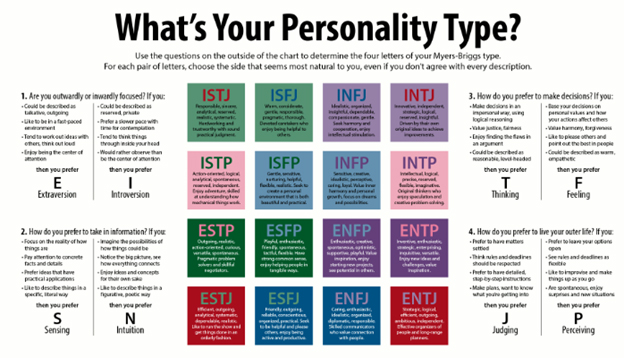
Myers Briggs Type Indicator (MBTI) for Human Resource Managers
“It is in your moment of decision that your destiny is shaped” – Tony Robbins
Individuals and corporation constantly take decisions, big or small and I strongly believe who and where we are is the direct consequence of who we have become as the result of series of conscious or unconscious decisions we have made in the past although executive level leaders assert the decisions to be more consciously and free of cognitive biases. This need for objectivity creates a market for objective test specially personality inventories for HR practices like recruitment or promotions. One of the most commonly used Personality inventories is the Myers Briggs Type Indicator (MBTI). In fact, they are so popular as to be nearly ubiquitous in corporations and large organizations, including 89 of Fortune 100 companies.
Here is what I understand:
A Swiss Psychologist and one of my personal idols and a pioneering figure in psychology only second to Sigmund Freud, Carl Jung, (1875 – 1961) theorized that you can predict differences in people’s behavior if you know how they prefer to use their mind. According to Jung, we each have an inborn preference for using our mind in one of two different ways, in four different categories:
1. Orientation to World
Extroverted -Energized by others OR Introverted -Energized by ideas, emotions, memories
2. Take in Information
Sensing -Using five senses OR Intuition -Using gut or instincts
3. Make Decisions
Thinking -Logical, problem solvers OR Feeling -Consider others, compassionate
4. Take in Info. or Decide
Perceiving -Taking in information OR Judging -Organizing information and making decisions
Later Around 1940s a mother-daughter team, Katharine C. Briggs and her daughter Isabel Briggs Myers, developed this instrument to help people understand and use Carl Jung’s theory of psychological type preferences.
MBTI identifies a total of 16 possible “types” based on unique combinations of the preferences. Four letters are used to represent a type, for example a person with preferences for Extraverted, Sensing, Thinking, Judging is called an ESTJ. Each type has strengths and weaknesses. No type is better than another. People can use this assessment tool to validate their preferences on each of the four dichotomies and understand the sixteen different personality types that result from the interactions among preferences.
21 Benefits of using MBTI for HR Managers
- Avoid and resolve conflicts
- Play to an individual’s strengths
- Identify gaps in the team
- Discover how your team style works best with customers
- Enable self-understanding and so reduce stress
- Help you learn to relax
- Aid career development
- Assist communication strategies
- Provide managers with the understanding to give effective feedback
- Inform personal development plan
- Work together more effectively
- Relate to each other with greater understanding
- Encourage true psychological diversity
- Support people through life transitions
- Inform your own and others decision making
- Develop thinking skills
- Develop emotional intelligence
- Identify and develop strengths and weaknesses
- Develop leaders, managers, teams and HR expertise
- Encourage team members to understand and appreciate different strengths
- Improve and change culture.
Find Your Personality Type
To find out your personality type write your email address in the comments and I will send you a short 70 item inventory. After answering the questions, you can cross check it with this matrix.
References
- com“21 Benefits of Using Myers Briggs Type Indicator”
- Career Routes 2 Success “Careers for Personality”
- com
Leave a Reply